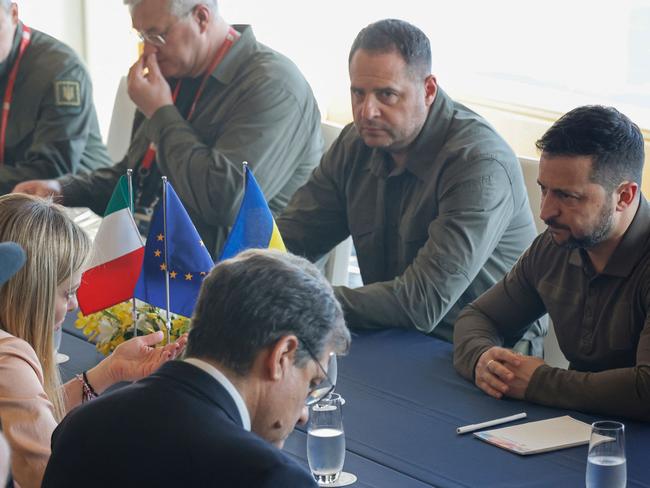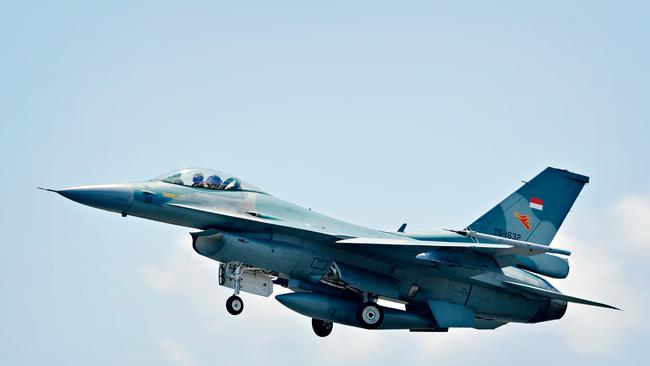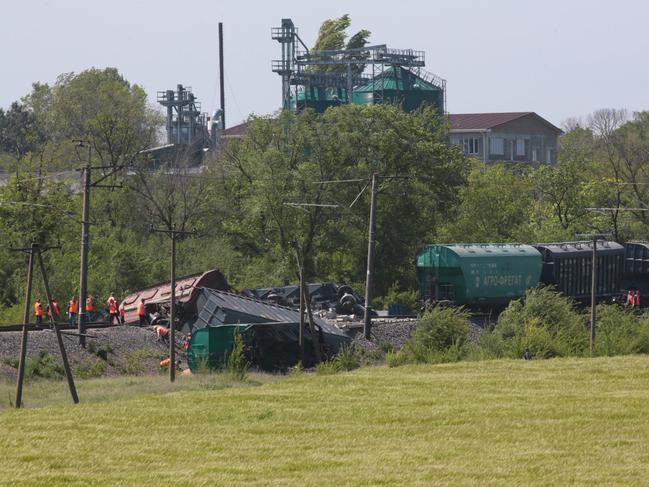Ukraine war: Zelensky compares Bakhmut destruction to Hiroshima bombing; wins new G7 military and diplomatic support
Volodymyr Zelensky says photos of Hiroshima after 1945 bombing remind him of the destroyed Ukrainian city of Bakhmut, saying “there is absolutely nothing alive”.

World
Don't miss out on the headlines from World. Followed categories will be added to My News.
President Volodymyr Zelensky has compared the “total destruction” of the Ukrainian city of Bakhmut to the 1945 devastation of Hiroshima, now hosting the G7 summit, after it was hit by a US atomic bomb.
Bakhmut, which had a pre-war population of 70,000 people, has been the scene of the longest and bloodiest battle in Russia’s invasion.
Occasional footage from Bakhmut during months of heavy fighting have shown a city of ruins.
“The photos of Hiroshima remind me of Bakhmut. There is absolutely nothing alive. All the buildings are destroyed,” Zelensky said.
“Absolute total destruction. There is nothing. There are no people.”

Zelensky said that Japan rebuilding of Hiroshima inspired him to rebuild Ukrainian cities and towns destroyed in the invasion.
“Now, Hiroshima is rebuilt,” he said.
“We dream of rebuilding all our cities that are now in ruins and every village where not a single house is left after Russian strikes.”
Zelensky spoke a day after Russia claimed to have fully taken control of Bakhmut.
Without giving a clear answer, Zelensky said Russian troops were in Bakhmut but insisted it was “not occupied”.
ZELENSKY WINS NEW G7 MILITARY AND DIPLOMATIC SUPPORT
President Volodymyr Zelensky secured more arms, munitions and “unwavering” diplomatic support from G7 allies in Hiroshima Sunday, as Russia claimed victory in the battle for a devastated eastern city.
Meeting leaders from a bloc of rich democracies, Zelensky won a commitment from US President Joe Biden to provide yet more “ammunition, artillery, armoured vehicles” on top of access to F-16 jets.
Top Zelensky aide Andriy Yermak said the US package included additional ammunition for HIMAR rocket launchers, artillery shells, anti-tank guided missiles and thermal imaging systems worth $375 million.

Zelensky’s surprise trip to Japan has been a major diplomatic coup, putting his country and Russia’s 15-month-long invasion firmly at the top of the agenda.
But success in the negotiating rooms contrasted sharply with difficulties on the ground, as he reflected on the months-long battle for Bakhmut and new Russian claims to have taken control of the eastern city.
Asked about the fate of the former salt-mining town of 70,000 people, Zelensky was notably downbeat, saying “you have to understand there is nothing” there.
“For today, Bakhmut is only in our hearts,” he said.
Ukrainian forces have tried for months to keep a toehold on the town, forcing Moscow to commit significant numbers of troops there in the process.
On Saturday, Russian President Vladimir Putin congratulated mercenaries from the Wagner organisation and regular units for the operation to “liberate” the town.

Zelensky’s invitation to visit Hiroshima, a city synonymous with the horrors of nuclear war, was a “deeply meaningful” symbol of support, according to host Fumio Kishida, Japan’s prime minister.
“By inviting President Zelensky to Japan, we demonstrated the unwavering solidarity of G7 with Ukraine,” he said.
As well as securing backing from allies, the visit afforded Zelensky a rare opportunity to win over a handful of nations who have pointedly offered little or no condemnation of Russia’s invasion.
Leaders from India, Brazil, Vietnam and Indonesia were among those invited to attend the summit as non-members.
Brazil’s President Luiz Inacio Lula da Silva has accused the West of “encouraging the war” and is yet to confirm he will even meet his Ukrainian counterpart.
The reception was warmer however from India’s Prime Minister Narendra Modi, who told Zelensky: “I understand your pain and the pain of Ukrainian citizens very well.”
“I can assure you that to resolve this India and, me personally, will do whatever we can do.”
Zelensky offered an upbeat assessment of the encounter, saying he believed India “will participate in the restoration of the rules-based international order that all free nations clearly need.”
ZELENSKY’S LANDMARK JAPAN VISIT TO TALK WITH G7 LEADERS
Ukraine President Volodymyr Zelensky made a landmark visit to Hiroshima for talks with G7 leaders Saturday, after securing long-sought access to advanced US fighter jets for Ukraine’s war effort.
Zelensky’s surprise summit appearance — he had been expected to appear by video call — is his furthest foray from Kyiv since Russia’s invasion began 15 months ago.
He arrived significantly buoyed by what he called a “historic” White House decision to allow Ukraine access to F-16 jets, among the most sophisticated materiel yet supplied by the West.
The group of seven rich democracies were huddled in Japan to discuss issues including the need for “constructive and stable” relations with China, which the bloc accused Saturday of “economic coercion”.

But it was Zelensky’s arrival, and debate about the future of the war in Ukraine, that has dominated the summit.
On landing, Zelensky said the summit would bring “increased cooperation for our victory”, and he declared that “today, peace will be closer”.
After a bloody winter of fighting that saw Russian gains in the eastern city of Bakhmut, Ukraine’s forces have regrouped for a counteroffensive but they remain dependent on the flow of Western weaponry.
Military experts say the aircraft would be a significant upgrade from Ukraine’s ageing Soviet-era fleet, offering greater ability to eventually strike targets in the air or on the ground.
They are also a potent symbol of Western support for Ukraine, forestalling any talk of waning interest as the conflict grinds on.

Mick Ryan, a strategist and retired Australian major general, called the decision “very significant”.
“F-16s have the sensors and weapon systems that are either equal to, or overmatch, Russian fighters,” he told AFP, saying the jets would make life “more difficult” for Russian missile-launching aircraft operating in and around Ukraine.
Until now, US President Joe Biden had effectively vetoed the transfer of US-made F-16s, with officials citing long pilot training times and the risk of escalating the conflict with Russia.
US National Security Advisor Jake Sullivan insisted there had been no about-turn in US policy, and the decision was based on the “exigencies of the conflict”.
“We’ve reached a moment where it’s time to look down the road and to say, ‘What is Ukraine going to need … to be able to deter and defend against Russian aggression?’”
He added that Ukraine had committed to not using US military equipment to hit targets inside Russia.
“We are going to do everything we can to support Ukraine in its defence of its sovereignty and territorial integrity, and we are also going to proceed in a way that avoids World War III,” he said.

With the US veto lifted, Prime Minister Rishi Sunak quickly announced that Britain would “work together with the USA and the Netherlands, Belgium and Denmark to get Ukraine the combat air capability it needs”.
Zelensky’s trip offers a chance to confer with allies, but perhaps more importantly to woo key unaligned powers also joining the summit, including India and Brazil.
Photos posted online by Prime Minister Narendra Modi’s staff showed the pair shaking hands and holding their first meeting since the invasion, which India has declined to condemn.
“There is an opportunity for Zelensky to engage with these non-Western actors, to try to bolster support, or at least weaken what may be seen as ambivalence towards the conflict,” Ian Lesser, vice president of the German Marshall Fund think-tank, told AFP.
“And they do matter. They matter especially in terms of sanctions, of course,” he added.
Zelensky also met separately with the Italian and British prime ministers, and talks with the French and US presidents are expected.

Ahead of Zelensky’s arrival, G7 leaders issued a joint statement Saturday denouncing efforts to “weaponise” trade and supply chains, saying they would “fail and face consequences” — a thinly veiled warning to China.
The bloc said it would also address vulnerabilities in supply chains for “critical goods” like minerals, semiconductors and batteries.
“What we have done over 20 years with China, encouraging development, was right, but maybe we should have been more careful on critical material, supply chains and those elements,” an EU official said.
The grouping also warned China against its “militarisation” in the South China Sea and urged Beijing to press Russia to end its invasion of Ukraine.
The bloc insisted however it still seeks “constructive and stable relations” with China.
US SIGNALS F-16 FIGHTER JETS FOR UKRAINE IN MAJOR ESCALATION
US President Joe Biden told G7 leaders that Washington will support training Ukrainian pilots on F-16 fighter jets that could be supplied to Kyiv, a senior White House official said Friday.
Biden said the United States “will support a joint effort with our allies and partners to train Ukrainian pilots on fourth-generation fighter aircraft, including F-16s, to further strengthen and improve the capabilities of the Ukrainian Air Force,” the official said.
“As the training takes place over the coming months, our coalition of countries participating in this effort will decide when to actually provide jets, how many we will provide, and who will provide them,” they added.

RUSSIA’S DIAMOND TRADE SANCTIONED
The United States and its G7 allies rolled out new sanctions against Russia’s “war machine” on Friday, targeting Moscow’s lucrative diamond trade and more entities linked to the invasion of Ukraine.
Leaders from the Group of Seven wealthy democracies are meeting in Hiroshima, Japan, with Russia’s $4-5 billion annual trade in diamonds in the crosshairs.
Vladimir Putin’s invasion of Ukraine 15 months ago has prompted waves of sanctions that have helped plunge his country into recession and drained the Kremlin’s war chest.
The G7 is now looking to tighten the screws further, strengthening existing sanctions, closing loopholes and subjecting more Russian firms and their international partners to punitive restrictions.
Ukrainian President Volodymyr Zelenskyy is expected to address the summit over the weekend by videolink, with hosts Japan tamping down speculation he could make a last-minute, in-person appearance.

Washington got the ball rolling on more sanctions early Friday, with a senior US administration official saying 70 more entities from Russia and “other countries” would be placed on a US blacklist.
“And there will be upwards of 300 new sanctions against individuals, entities, vessels and aircraft,” the official said.
As the G7 weighs how to collectively choke Russia’s trade in diamonds — including high-tech methods of tracing — Britain announced its own “ban on Russian diamonds”.
London said it was also targeting imports of aluminium, copper and nickel.
“As today’s sanctions announcements demonstrate, the G7 remains unified in the face of the threat from Russia and steadfast in our support for Ukraine,” said Prime Minister Rishi Sunak. The G7 is likely to stop short of an outright ban on Russian diamonds, at least for now. But according to officials, the summit will signal a determination to act.
“Russian diamonds are not forever”, said EU Council President Charles Michel. “We will restrict trade in Russian diamonds.”

EU member state Belgium is among the largest wholesale buyers of Russian diamonds, along with India and the United Arab Emirates.
The United States is a major end-market for the finished product. Economists are divided about just how much G7 and other sanctions have hurt the Russian war effort.
The Russian economy contracted 2.1 per cent in 2022, a trend that continued early this year. But Moscow has adapted quickly, introducing strict capital controls, diverting trade to allies like China and reportedly borrowing evasion techniques from much-sanctioned countries like Cuba, Iran and North Korea.
The International Monetary Fund has projected a modest 0.7 per cent economic rebound in 2023.
KYIV HIT WITH UNPRECEDENTED RUSSIAN BARRAGE
Ukraine said it had downed nearly an entire barrage of Russian missiles in the latest of an “unprecedented” wave of aerial attacks on the capital Kyiv.
The defence ministry said Russian forces had launched 30 cruise missiles from land, sea and air, targeting several regions and killing one person in the southern port of Odessa and another in the northeastern region of Kharkiv.
The military said its air defence units had destroyed 29 of the cruise missiles and shot down four drones.
Russian strikes on the capital Kyiv have reached an intensity not seen since a wave of attacks started last autumn.
“A series of air attacks on Kyiv, unprecedented in their power, intensity and variety, is continuing,” said Sergiy Popko, head of Kyiv’s civil and military administration.

The attack follows other recent barrages in which Ukraine claimed to have downed several of Russia’s much-vaunted hypersonic Kinzhal missiles.
Valery Zaluzhny, commander-in-chief of Ukraine’s armed forces, said that the most recent barrage included six Kalibr missiles and two Iskander-K missiles.
The United States also confirmed that one of its Patriot air defence systems supplied to Kyiv had been damaged, following claims by Russia its forces had destroyed one of the advanced systems.

In the southern port city of Odessa, one person was killed and two were wounded after a missile hit industrial infrastructure, the military said.
One person died and two more were wounded as a result of a missile strike on the village of Tsyrkuny in the northeastern region of Kharkiv, governor Oleg Sinegubov said.
In Kyiv, officials reported explosions in the Desnyansky district in the northeast and said a fire had broken out at a business in the southeastern neighbourhood of Darnytskyi as a result of falling debris.
The military also reported “cruise missile” attacks in the central Vinnytsia region, while local authorities also reported explosions in Khmelnytskyi, about 100 kilometres (60 miles) further west.
The Russian defence ministry said that its forces hit “all” targets. Moscow did not specify which targets had been hit, only saying it aimed at “large depots of foreign weapons and equipment as well as enemy reserves.”
TRAIN DERAILMENT IN CRIMEA
Separately, a train carrying grain derailed in the Russian-annexed Crimean peninsula in what Moscow-installed officials called a deliberate act.
“Train carriages loaded with grain derailed in the Simferopol region,” said Crimea head Sergei Aksyonov. The railway operator said the incident was caused by “the intervention of third parties”.
Telegram channel Mash, which claims to have sources close to Russian law enforcement, said the disruption was caused by an explosive device that left a large crater.


One regional parliament member also said the incident was caused by an explosive device, without giving evidence.
Baza, another Russian Telegram outlet with police sources, distributed images of what it said was the aftermath of the incident, showing several overturned rail cars.
Earlier this month, explosive devices derailed two Russian trains in a region bordering Ukraine over consecutive days.
Crimea, annexed from Ukraine in 2014, has been hit intermittently by explosions at military facilities since Moscow ordered troops into Ukraine in February 2022.
With AFP
More Coverage
Originally published as Ukraine war: Zelensky compares Bakhmut destruction to Hiroshima bombing; wins new G7 military and diplomatic support




